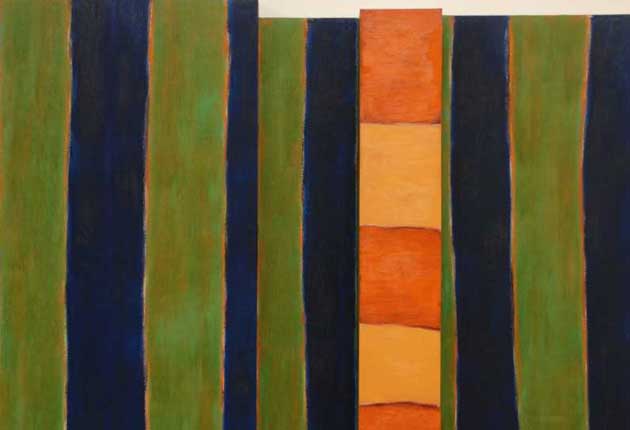Sean Scully: Paintings from the Eighties, Timothy Taylor Gallery, London
When Scully took off his perfectly sterile gloves

By the early 1980s, the Dublin-born painter Sean Scully was not only an American citizen, resident in New York City, but also thoroughly Americanised in his painterly habits. At first he had learnt a lot from the rigour, the austerity and the restricted palette of some of the Abstract Expressionists. Then, in the 1970s, he worked through a period of what might be described as Minimalist-inspired abstraction – smallish works on the whole, often grid-like in form, without much colour to relieve their severity. There was a certain chilliness about some of that earlier work, as if painting was a problem to be solved in a rather inhuman laboratory, bereft of much evidence of human presence. The human hand, when it was present at all, felt locked inside a perfectly sterile glove.
But the 1980s, as you will see from this exhibition of just seven key works which pretty well span the decade, saw not only a consolidation, but also a breaking out, a taking flight, into something rougher, more colourful, more keenly engaged with the tones and the colours and the textures of the world itself. A human warmth, and even an endearing earthiness, creep in. The colours become thicker, denser, more akin to the complicated, variegated tones of the earth across which we walk, less factitious, less manufactured. Scully's tones, much subtler than in the recent past, even begin to have what looks like an earthbound aroma to them – though, in all truth, they are still entirely odourless. The colours are also suggestive of the moods of weather – particularly dense browns, oranges and blues that feel muggy, fuggy, close. These paintings are both in the world and of the world.
Scully is a painter of stripes in contention with stripes. He butts them up against each other. They are locked together, very close indeed. They flow in one direction, and then another. But by the 1980s these are not clean-lined, perfect stripes by any means. They are rough-edged, wavy, subject to the imperfect movement of the human hand.
During this decade he was also creating a new kind of painting, which consisted of several panels of different depths, all locked together. One panel sticks out – thrusts out might be a better way of describing the painting's sense of brute assurance – further from the wall than another. This looks and feels surprisingly disruptive. You are no longer sure whether you are seeing a thing or some kind of illusory surface. There is another reason to feel unsettled: though the paintings often look like near-regular rectangular forms, they are less so than they seem at first. Nothing is quite squared off.
The world is present in very particular ways in a number of these paintings. In The Bather, the panel that juts out from the rest is reminiscent of the figure of a bather, stepping out, ready to jump, and then scream with horror or delight at the temperature of the water. Yes, the stripes remind you of the colours, the seaside gaiety, of mother's embarrassingly blary bathing suit, all splashy oranges and reds.
The rhythms of a painting can suggest the rhythms of elemental things out in the world. Look at Swan Island, for example. The striped panels resemble the flow and the counter-flow of water. The paint feels unsettled, as if in motion. It drives across what look like thick, massy surfaces – surfaces with some weight, heft, density; surfaces that would push back, hard, if you happened to bump into them. So don't.
To 14 February (020-7409 3344)
Subscribe to Independent Premium to bookmark this article
Want to bookmark your favourite articles and stories to read or reference later? Start your Independent Premium subscription today.

Join our commenting forum
Join thought-provoking conversations, follow other Independent readers and see their replies